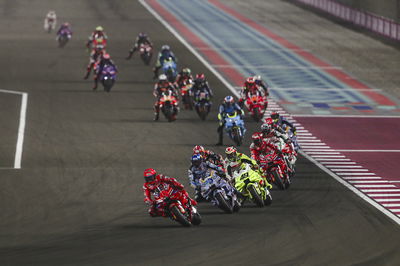Aoyama 'electronics-off' strategy explained.

The modern breed of peaky 800cc MotoGP bikes, it is said by some, would be almost unrideable without their extensive range of electronic riding aids.
As such, when sending a rookie out for his very first MotoGP laps, it might be expected that the team would crank the electronics to a maximum and then reduce the level of 'assistance' as time goes on.
So why did the new Interwetten Honda team do exactly the opposite with Hiroshi Aoyama?
Technical director Tom Jojic, with Honda's blessing, initially sent the final 250cc world champion out for his MotoGP debut at the Valencia test without electronic assistance - a tactic repeated during the Japanese star's second test at Sepang in late December.
"Basically at Valencia my idea was to limit the electronic aids - and Honda were happy for me to do that," said Jojic, speaking exclusively to Crash.net. "After I made the suggestion, Honda were happy to go in that direction also."
A brave decision?
"Yeah... But we have to remember that although Hiro is a MotoGP rookie he is also a world champion," he replied. "The guys that win races in this [MotoGP] world championship are basically all former 250cc world champions - Casey was close enough but never made it. These guys are the best riders in the world. If he can't control it nobody can.
"So what I wanted to do was, first of all, not put any pressure on Hiro from a lap time point of view. Because there is no need. We're testing. If we're slower than the rest in Valencia who cares? Because we've switched all the electronic aids off.
"And why hide a character trait in the bike from the rider, when ultimately he needs to learn what it's going to do?"
So you didn't want to 'numb' the true character of the bike through the electronics?
"Exactly. I wanted him to feel what the Honda is. Go out there, ride around and see what he thinks. I know we can switch electronics on and stop it doing certain things, but Hiro needs to know when to do that. He needs to know when to ask for the help.
"So that was the plan and in Valencia we did eventually start to turn some of the electronics on. Not a great deal. My philosophy is don't over-control anything. If he's complaining then we'll help him, if he isn't we'll leave him alone.
"We [the team] can look at the data and know, from our experience, how a MotoGP rider can change their style or where we need to help from our side by changing the bike. Our experience helps him and him being a world champion helps us. And the sooner he understands the bike the easier it is for him to ask for things.
"When we got here [to Sepang] we started where we'd finished in Valencia. We didn't give him anything new except the gearbox, which changes the engine character anyway, and from there it's been a step-by-step process."
Speaking separately, Aoyama confirmed that he spent the first day at Sepang without any electronic controls, with the electronics then gradually introduced on days two and three.
"We try to keep it as simple as possible," outlined Jojic. "Listen to his comments. Listen to what he needs and work on the problem he has. If it's a technical bike set-up issue we change that, if it's his 250 riding style then we look at that. He's actually really good. He's coming in with 'I think it's me that's not doing it right'."
Aoyama feels that he's presently carrying too much mid-corner speed, which is hurting his ability to get the most out of the powerful MotoGP bike on corner exit.
"He's still riding with a 250cc style, but he has adapted," confirmed Jojic. "In the short time I've been working with him he has already changed. He knows he needs to work on it more, but that is something he can also do while training during the off-season.
"Hiro's basically decided to ask as many questions as he can, to both us and Honda, and we try to show him what MotoGP race winners do, because luckily we have a wealth of information in the garage, in terms of data and/or experience. Overall it's going very well."
Aoyama was the slowest MotoGP rider on all three days at Valencia - but was fastest on all three days of his rookie test at Sepang, where he was riding alongside former 250cc title rival Marco Simoncelli and the Honda test team.
Aoyama improved his lap time by almost one second on each day to finish 0.9sec clear of Simoncelli's Gresini Honda and just a few tenths from the race lap record of 2min 2.108sec - although the official best circuit lap is a 2min 0.518sec, set by Valentino Rossi during qualifying for the 2009 Malaysian Grand Prix.
Jojic meanwhile is returning to frontline MotoGP action in 2010, having previously been part of Kawasaki's test and development team. But while the RCV chassis is completely new to him, Jojic has worked on a Honda-powered MotoGP bike before, during 2006 and 2007 at Team Roberts.
How has the RCV changed since then?
"Generally I would say that things have evolved - we were using spring valves then and now we have pneumatics for example," he replied.
"On the engine management [electronics] side the complexity of the system hasn't really changed, but how they are using the engine management has. So hardware-wise 'no' [big change], but software-wise 'yes'."












